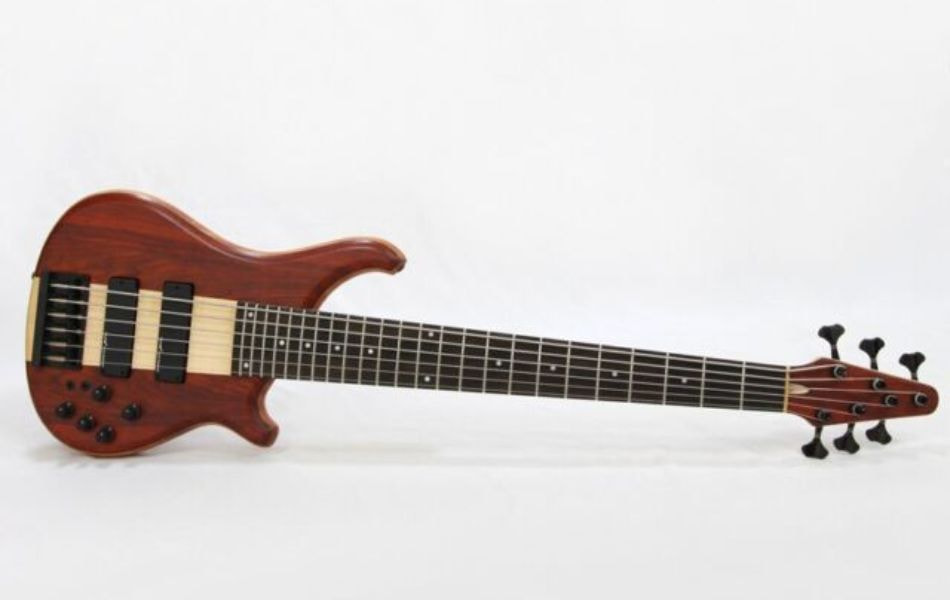The 6-string bass guitar, a dynamic and versatile instrument, opens up a realm of possibilities for musicians. Tuning 6-string bass guitar is an art that allows players to customize their sound and playability to suit diverse musical genres and styles. Join us as we uncover the intricacies of 6-string bass guitar tuning, providing insights and guidance to help you harness its full potential.
Contents
Contrast a 6-string bass guitar and a guitar
A 6-string bass guitar and a guitar are both stringed instruments, but they differ in several key aspects:
Guitar tuning is usually E-A-D-G-B-E from the thinnest to the thickest string. Whereas, the 6-string bass guitar tuning is typically tuned to B-E-A-D-G-C (from thickest to thinnest string), which is a fourth lower than the standard guitar tuning.
Guitars have a higher pitch and a broader range in the treble frequencies compared to a 6-string bass guitar. The bass guitar is designed to produce lower frequencies and covers the bass and lower midrange range.
Guitars generally have a shorter scale length compared to 6-string bass guitars. It contributes to a higher pitch and often easier playability, especially for complex chord shapes and solos. In contrast, 6-string bass guitars have a longer scale length to accommodate the lower tunings and maintain proper tension on the thicker strings.

How to tune 6-string bass guitar
Understanding the distinctions between a bass and a guitar is crucial for effectively learning and tuning a 6-string bass guitar. The knowledge of differences in tuning, string count, tone, and playing technique helps ensure that you can tune the 6-string bass accurately and utilize it effectively based on its unique characteristics and role in music.
6-string bass guitar tuning involves adjusting the pitch of each string to achieve the desired notes. The standard tuning for a 6-string bass guitar is B-E-A-D-G-C, but you can use different tunings based on your musical preference or the requirements of a specific song.
Best strings for bass guitar 6-string
When it comes to long-scale bass guitars, finding ready-made string sets specifically tailored for tuning to E can be quite a challenge. In light of this, a practical suggestion is to opt for a standard 4-string set, which will work seamlessly for the first 4 strings of the 6-string bass.
In this scenario, the most effective approach is to individually purchase the strings for the high B and E strings. Fortunately, there’s a diverse array of single strings available in the market, and Ernie Ball stands out for its remarkable selection. For the high B, a .040 gauge string is a reliable choice, while a .030 gauge string is ideal for achieving the desired pitch on the high E.
By carefully selecting and assembling these strings, you can ensure that your 6-string bass guitar attains the intended tuning with optimal sound quality and playability. This method offers a practical solution to tailor your string setup to accommodate the unique tuning requirements of the instrument, ensuring a fulfilling musical experience.

Popular 6-string bass guitar tuning
Drop C tuning
Drop-C tuning involves dropping the lowest string (B) down to C, resulting in the tuning C-G-C-F-A-D (from thickest to thinnest string). This tuning is indeed popular in heavy metal and hard rock genres due to the heavier and deeper sound it provides.
It allows for powerful, low-end riffing and provides a heavier foundation for these aggressive musical styles. It’s a go-to tuning for many metal and hard rock bassists looking to achieve that signature heavy sound.
Standard tuning
The standard tuning for a 6-string bass guitar, from the thickest (lowest pitch) string to the thinnest (highest pitch) string, is typically B-E-A-D-G-C. Here’s the breakdown:
- B (thickest string, lowest pitch)
- E
- A
- D
- G
- C (thinnest string, highest pitch)
This standard tuning is widely used and provides a good balance of low-end depth and the ability to play higher register notes, making it suitable for a wide range of musical genres and styles.
Half-step down tuning
In half-step down tuning, each string is tuned down by one half-step (one semitone) compared to standard tuning. Starting from the thickest (lowest pitch) string to the thinnest (highest pitch) string, the tuning is as follows:
Bb-Eb-Ab-Db-Gb-Bb (from thickest to thinnest string).
Half-Step Down Tuning results in a slightly lower and heavier sound compared to standard tuning, giving a different tonal color and making it easier to play in certain keys.
Tuning this remarkable instrument is more than a technicality. It’s an opportunity to craft a personalized sonic identity. With an extended range, the 6-string bass guitar empowers musicians to create a rich tapestry of sound. As we conclude our exploration of 6-string bass guitar tuning, we celebrate the potential and versatility it brings to the world of music.
